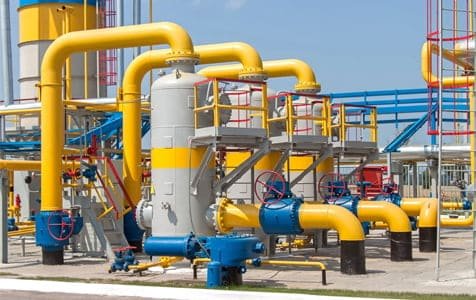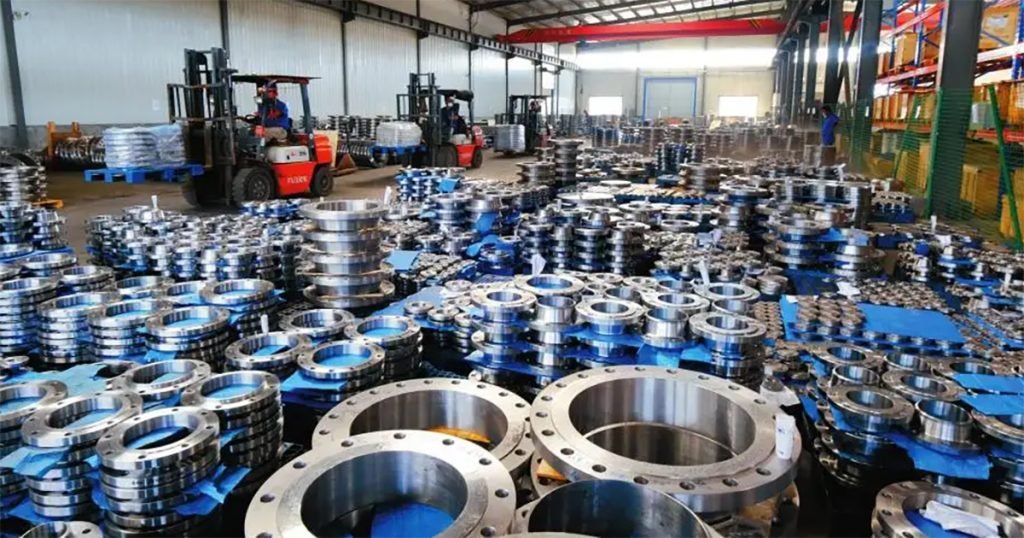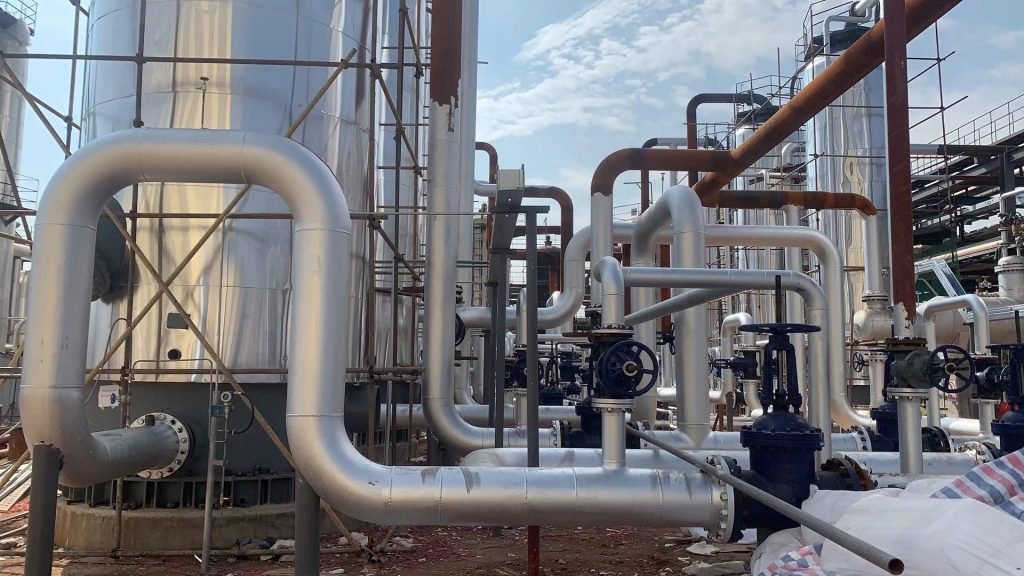How to choose the pipe flange that suits you?
Choosing the right pipe flange for your application can be a complex process that depends on several factors, including the type of piping system, the temperature and pressure of the fluid being transported, the size and material of the pipe, and the specific requirements of your application.



General Guidelines for Selecting the Right Flange
- Determine the type of flange: Different types of flanges are designed to fit specific piping systems, so it’s important to choose a flange that is compatible with your system. For example, if you have a high-pressure system, you may need a weld neck or threaded flange, whereas if you have a low-pressure system, a slip-on or lap joint flange may be sufficient.
- Consider the pressure and temperature: The pressure and temperature of the fluid being transported are critical factors in determining the appropriate flange. Higher pressure and temperature requirements typically require a stronger and more durable flange. ASME/ANSI B16.5 is the most common standard for pressure and temperature ratings for flanges, so make sure to choose a flange that meets the requirements of this standard.
- Select the appropriate material: Flanges are available in a range of materials, including carbon steel, stainless steel, and various alloys. The material you choose will depend on the corrosiveness of the fluid being transported, as well as other factors such as temperature and pressure. For example, stainless steel is a popular choice for applications involving corrosive fluids or high temperatures.
- Consider the size and dimensions: The size of the flange should match the size of the pipe, and the dimensions of the flange should conform to industry standards. Be sure to choose a flange that is the right size and dimensions for your piping system to ensure a secure and leak-free connection.
- Evaluate the flange’s performance: Look for flanges that are designed for reliable and long-lasting performance. Consider factors such as ease of installation, maintenance requirements, and the ability to withstand stress and vibration.
- Seek expert advice: If you are unsure which flange is the right fit for your specific application, seek the advice of a qualified engineer or supplier who can guide you through the selection process.
By taking these factors into consideration, you can choose the pipe flange that best suits your application, ensuring a safe and efficient piping system.



The most common specifications and sizes for pipe flanges:
Pipe flanges come in a variety of specifications and sizes, depending on the needs of the piping system.
ASME/ANSI B16.5: This is the most widely used standard for pipe flanges in the United States. It covers flanges from ½ inch to 24 inches in size, with pressure ratings from 150 to 2500 pounds per square inch (psi).
ASME/ANSI B16.47: This standard covers larger pipe flanges from 26 inches to 60 inches in size, with pressure ratings from 75 to 900 psi.
MSS SP-44: This standard covers flanges from 12 inches to 60 inches in size, with pressure ratings from 150 to 900 psi.
API 6A: This standard covers flanges used in the oil and gas industry, with sizes ranging from 2-1/16 inches to 30 inches in size and pressure ratings up to 20,000 psi.
DIN: This European standard covers flanges from 10 mm to 4000 mm in size and pressure ratings up to 400 bar.
JIS: This Japanese standard covers flanges from 10A to 500A in size and pressure ratings up to 63 kg/cm².
Flanges come in various sizes, which are measured in inches (in) or millimeters (mm). The most common sizes for pipe flanges in the United States are ½ inch, ¾ inch, 1 inch, 1-1/2 inch, 2 inch, 2-1/2 inch, 3 inch, 4 inch, 6 inch, 8 inch, 10 inch, 12 inch, 14 inch, 16 inch, 18 inch, 20 inch, 24 inch. Larger sizes are also available, as per the specifications mentioned above.
It’s important to choose the right size and specification of pipe flange for your application, to ensure that it will fit your piping system and meet the pressure and temperature requirements. Consult the relevant standards and a qualified engineer or supplier for guidance on selecting the appropriate flange for your application.

Material of pipe flange
Pipe flanges are typically made from a variety of materials, depending on the application, process fluid, and operating conditions. Here are some common materials used for pipe flanges, and factors to consider when choosing the appropriate material for your application:
- Carbon steel: Carbon steel flanges are a popular choice for low-pressure and low-temperature applications. They are available in different grades such as ASTM A105, ASTM A350 LF2, and ASTM A694 F60, among others. Carbon steel flanges are cost-effective, durable, and easy to work with.
- Stainless steel: Stainless steel flanges are used in high-temperature and high-pressure applications where corrosion resistance is a key requirement. They are available in grades such as ASTM A182 F304, ASTM A182 F316, and ASTM A182 F347, among others. Stainless steel flanges are more expensive than carbon steel but offer excellent corrosion resistance and durability.
- Alloy steel: Alloy steel flanges are used in high-temperature and high-pressure applications where corrosion resistance and high strength are required. They are available in grades such as ASTM A182 F11, ASTM A182 F22, and ASTM A182 F91, among others. Alloy steel flanges are more expensive than carbon steel but offer excellent strength and durability.
- Non-ferrous metals: Non-ferrous metal flanges, such as those made of copper, brass, and aluminum, are used in applications where the process fluid is corrosive to ferrous metals. They are also used in applications where weight is a concern, such as in the aerospace industry.



How to choose flange material
When choosing the material for your pipe flange, consider the following factors:
- Temperature and pressure requirements: Choose a material that can withstand the temperature and pressure requirements of your application.
- Corrosion resistance: Choose a material that is resistant to the process fluid and environment in which it will be used.
- Cost: Consider the cost of the material, including the initial purchase cost, as well as the long-term maintenance and replacement costs.
- Availability: Choose a material that is readily available and can be sourced easily.
- Compatibility: Choose a material that is compatible with the piping system and process fluid.
Consult with a qualified engineer or supplier for guidance on selecting the appropriate material for your pipe flange, taking into account the specific requirements of your application.



How to choose the type of pipe flange
When choosing the type of pipe flange, consider the following factors:
- Application requirements: Consider the pressure, temperature, and process fluid of the piping system. Certain types of flanges, such as weld neck flanges, are better suited for high-pressure applications, while slip-on flanges are more commonly used in low-pressure systems.
- Piping system design: Consider the design and layout of the piping system, as some types of flanges may be better suited to specific piping configurations.
- Flange material: Consider the material of the flange and its compatibility with the process fluid and environment.
- Cost: Consider the cost of the flange, including any additional components or accessories required for installation.
- Availability: Consider the availability of the flange, including lead time for delivery and availability of replacement parts.
- Industry standards: Consider any relevant industry standards, such as ASME/ANSI B16.5, which may dictate the type of flange required for certain applications.
It is important to consult with a qualified engineer or supplier to ensure that the correct type of flange is selected for your specific application. They can provide guidance on selecting the appropriate flange type and material, and can ensure that the flange meets all necessary specifications and requirements for your application.
Author: Lewis Liu
Hello, my name is Lewis Liu, and I’m a professional sales engineer with over a decade of expertise in the flange fittings sector.
I am quite informed about flange selection, installation, and maintenance. I am passionate about providing customers with the greatest solutions for keeping their pipeline systems running smoothly, safely, and dependably.
If you have any queries or concerns concerning flange fittings for your pipelines, whether they are about selection, material choice, specification requirements, or anything else, please contact me at any time. I am dedicated to providing expert advice and assistance to help you make educated decisions and reach your objectives.

